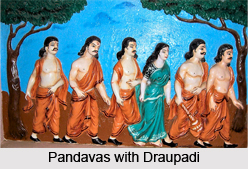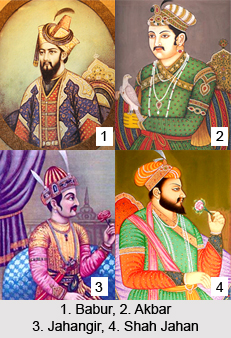 Ancient history says that the area in which Jind district lies formed an integral part of Kurukshetra in the traditional geographical account. It derived its name after Jainti, an ancient tirtha mentioned in Mahabharata and the Padma Purana, founded in honour of Jainti, the goddess of victory. According to a local tradition, Pandavas offered prayers to Goddess Jainti after their victory in the battle against the Kauravas. The antiquity of the district is established on the basis of the discovery of the Pre-Harappan, the Late-Harappan and the Painted Grey Ware pottery at various places from the district and the mention of its tirthas in the Puranas corroborates it.
Ancient history says that the area in which Jind district lies formed an integral part of Kurukshetra in the traditional geographical account. It derived its name after Jainti, an ancient tirtha mentioned in Mahabharata and the Padma Purana, founded in honour of Jainti, the goddess of victory. According to a local tradition, Pandavas offered prayers to Goddess Jainti after their victory in the battle against the Kauravas. The antiquity of the district is established on the basis of the discovery of the Pre-Harappan, the Late-Harappan and the Painted Grey Ware pottery at various places from the district and the mention of its tirthas in the Puranas corroborates it.
According to the history of Jind District, the district was first occupied by a pre-Harappan agricultural community. History of this stage is not very clear and it is not yet possible to state from where these people had moved here or to throw much light on their socio-economic life. However, on the basis of the evidence of the nearby pre-Harappan sites like Mitathal (Bhiwani district), Siswal, Banwali and Rakhigarhi (Hisar district), it may be stated that these people possibly lived in mud brick and thatched roof houses, used wheel-made pottery, terracotta and copper-made objects.
Further, the classical Harappan site of Rakhigarhi (Hisar District) about 15 kms from Jind suggests the existence of such sites also in Jind district, but it lacks proper excavations. After the Harappans, the region was inhabited by the late-Harappans (1700 BC - 1300 BC) whose pottery has been recovered from many places in the district. Around 1000 BC, with the advent of the painted Grey Ware people, generally associated with the Aryans, a new era dawned upon this district. The people representing this new culture settled on the banks of the holy rivers Saraswati and Drishadvati, and the region came to be known as the holy land of Kurukshetra.
 The mention of various tirthas of Jind District in Mahabharata and the Puranas points to the continuance of activities of the Aryans here. The region came under the sway of the Vedic Bharatas, Purus and the Kurus and was included in the kingdom of Pandavas under whom it touched the height of glory. King Parikshit, had his second capital at Asandivat (Asandh in Karnal district), very close to Jind district. As per historical accounts, this area was also included in the kingdom of the Kurus, which was one of the sixteen Mahajanapadas in the 6th century BC mentioned in Buddhist literature. It was also a part of the Nanda Dynasty. After the fall of the Maurya Empire, the region witnessed the rise of several important republican people. In the ninth and tenth centuries AD, the district formed part of the Pratihara Empire whose inscriptions have been found at Sirsa, Pehowa and Delhi. Later on, the Tomaras, the feudatories of the Pratihara dynasty came to power here.
The mention of various tirthas of Jind District in Mahabharata and the Puranas points to the continuance of activities of the Aryans here. The region came under the sway of the Vedic Bharatas, Purus and the Kurus and was included in the kingdom of Pandavas under whom it touched the height of glory. King Parikshit, had his second capital at Asandivat (Asandh in Karnal district), very close to Jind district. As per historical accounts, this area was also included in the kingdom of the Kurus, which was one of the sixteen Mahajanapadas in the 6th century BC mentioned in Buddhist literature. It was also a part of the Nanda Dynasty. After the fall of the Maurya Empire, the region witnessed the rise of several important republican people. In the ninth and tenth centuries AD, the district formed part of the Pratihara Empire whose inscriptions have been found at Sirsa, Pehowa and Delhi. Later on, the Tomaras, the feudatories of the Pratihara dynasty came to power here.
Medieval period of the history of Jind District suggests that after the demise of Shihab-ud-din Gauri, Qutub-ud-din Aibak established Turkish rule in northern India in 1206. The Haryana territory, including the present Jind district, formed a part of the Sultanate of Aibak. After the death of Firoz Shah Tughlaq (1388 AD), Jind District slipped out of the hands of the Tughlaqs. Lodis brought the district under their control in 1451 AD and retained it until 1526 when Babur, the founder of the Mughal Empire in India snatched it from Ibrahim Lodi.
Babur gave the entire Hisar division including Jind district to Humayun as a reward. Sher Shah Suri was an administrative genius. He divided his whole kingdom into sixty six sirkars. Jind came, as in the earlier time, under the Sirkar of Hisar. The administrative set-up during the reign of Akbar, Jahangir, and Shah Jahan underwent drastic changes after the death of Aurangzeb in 1707 which ushered in an era of chaos and confusion.
According to the modern history of Jind District, when India got its independence, the government merged Jind state with the newly created state of Patiala and East Punjab State Union (PEPSU) on July 15, 1948. With the formation of Patiala and East Punjab States Union (PEPSU) in 1948, the state was grouped into eight districts namely, Patiala District, Barnala, Bathinda District, Kapurthala District, Fatehgarh Sahib District, Sangrur District, Mahendragarh and Kohistan (Kandaghat). In 1953, the number of districts was reduced to five, by merging Barnala with Sangrur and Kandaghat and Fatehgarh Sahib with Patiala. Thus, Sangrur District comprised five tehsils, namely, Barnala, Malerkotla, Sangrur, Narwana and Jind.
Further, during the reorganisation of Punjab in 1966, Sangrur District was bifurcated and Jind and Narwana tehsils were allocated to Haryana and were constituted into Jind district. Jind tehsil was bifurcated into two tehsils of Jind and Safidon in 1967. In January 1973, 54 villages of Kaithal tehsil were transferred to Jind District, 43 going to Jind tehsil, 5 to Safidon tehsil and 6 to Narwana tehsil. One village namely, Barsola was transferred to Jind tehsil from Hansi tehsil of Hisar district in 1974.



















